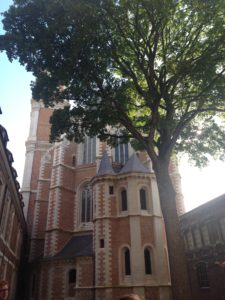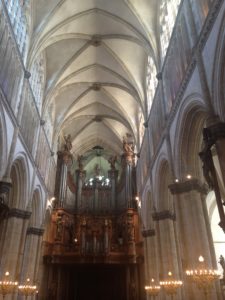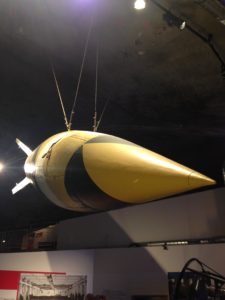Saint-Omer: City of Art and History
 At first glance, the town of Saint-Omer, located in the heart of France’s Nord-Pas-de-Calais region, seems an unlikely home for priceless historical artifacts or significant artistic institutions. Sure, the houses are old enough, but they have more wear and less popping color than the Disney-fied towns of the French Riviera. The somewhat bare streets, for their part, can give off an inhospitable air at night. Yet, within this unassuming town lies a litany of long-standing historical institutions and artistic finds.
At first glance, the town of Saint-Omer, located in the heart of France’s Nord-Pas-de-Calais region, seems an unlikely home for priceless historical artifacts or significant artistic institutions. Sure, the houses are old enough, but they have more wear and less popping color than the Disney-fied towns of the French Riviera. The somewhat bare streets, for their part, can give off an inhospitable air at night. Yet, within this unassuming town lies a litany of long-standing historical institutions and artistic finds.
The special significance of Saint-Omer for Georgetown has its origins centuries before our university was founded, when English Catholics fleeing the newly Protestant state founded a Jesuit college in Saint-Omer, thanks to its proximity to the Channel. This college remained open despite changes in rulers, wars, and religious division until three young brothers from a Catholic family in the American colonies began their studies there. These were the Carroll brothers, including Georgetown’s founder, John Carroll. I visited the immense space of the hollowed out college and witnessed its direct link between religious enlightenment and educational achievement, clear in the light streaming down from the vaulted windows.
Thanks to the detailed exhibitions created by the town’s administration, including a diorama of the Battle of Yorktown at an exhibition on Charles Carroll, the only Catholic to sign the Declaration of Independence, I felt a much deeper connection to the founders of my university, through their sojourn here, the difficulty of making do in French, and simultaneously the exhilaration of learning all on my own.
Even for a student of French history who may not have a personal connection to the city, Saint-Omer has a great deal to offer. Its cathedral, a stunning monument to the town’s religious significance in the late medieval era, contains numerous markers of the turbulent passage of time here. Above the door that Louis XIV entered when he conquered the region in the 17th century is an elaborate and ingenious clock which charts solar and lunar movements in a delicate dance of mechanical parts. On the exterior, the many saints adorning part of the their façade suffered defacement and decapitation during the turmoil of the French Revolution, showing how history continued to mold Saint-Omer.
Elsewhere in Saint-Omer, the French Revolution had an even greater effect on the St. Bertin Abbey, as the townspeople, inflamed by revolutionary fervor, tore down most of the building and preserved only its soaring frame. The stone skeleton, damaged by bombs in World War II, still stands, almost more imposing than it would have been whole, lit up at night to show the ingenuity and perseverance of its medieval builders.
Fast-forwarding a few centuries, just outside of Saint-Omer is La Coupole, a massive concrete dome and underground bunker complex for German V-2 rocket launches during World War II, built by forced French labor. Today the complex houses a planetarium and a museum about the history of the place, the war, and the space program. To walk through the chilly tunnels at the base of the dome, amid the displays about the horrible conflicts of the past, is to be transported back to the crushing conditions and dampness of the base’s operations.
Yet, despite the museum’s incredibly comprehensive and interesting exhibits on the war and the activities of its base, its most interesting feature is the link it reveals between the war and the space program: Wernher von Braun. The museum uses the story of the head of the Nazi V-2 program who became the lead American rocket designer after the war to illustrate the direct links between weapons technology and space exploration. All in all, it was a fascinating glimpse into the dark history now transformed into a place of learning.
My time in Saint-Omer taught me that history can hide even in the plainest of circumstances, whether in the brambles concealing a Nazi rocket base, or a deserted church where iconic American luminaries once studied. This phenomenon was mostly recently demonstrated when a copy of Shakespeare’s First Folio, the earliest complete recording of his plays was discovered in the library of Saint-Omer, only the 234th to be found in the world. Though while the thrill of discovery subsides, the breathing mass of history continues its march, offering us only a passing view between its crumbling bricks and decorated canvases. I found real engagement with the past in Saint-Omer, and I hope to return again to see its future.



